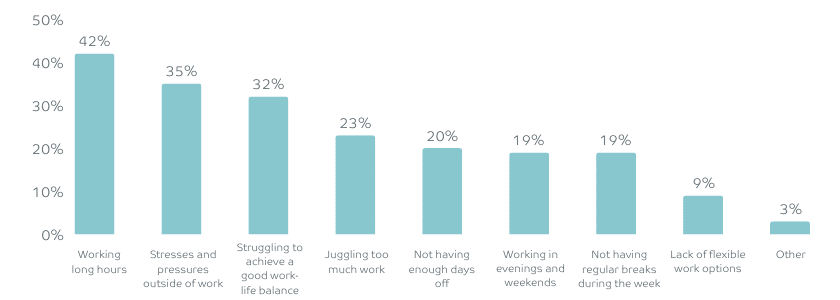In January 2025 we surveyed over 2,000 UK employees about the state of mental health and wellbeing. The results revealed that employee burnout is on the rise, leaving employees struggling with prolonged mental, physical and emotional exhaustion.
Recognising the risks allows us to take proactive steps to manage stress, identify early warning signs, and put support measures in place to help employees safeguard against burnout. We explore the trends with our data, as well as some clear risk factors for certain demographics, including age, gender, location and occupation.
What is driving burnout?
Our data discovered that working long hours (42%), stresses outside of work (35%) and struggling to achieve a work-life balance (32%) are of the most common causes of burnout:

Following on from these, the reasons for burnout were juggling too much work (23%), not having enough annual leave (20%), working outside of office hours (19%), not having regular breaks (19%) and a lack of flexible working options (9%).
This indicates that businesses need to address employee mental health and wellbeing within their organisations. Having daily check-ins with employees about their workload and wellbeing could help avoid longer-term issues such as presenteeism and extended absences from work.
Additionally, 73% of respondents say they feel burnt out all the time, quite often or occasionally. It’s important for managers to feel confident having open conversations to address these issues before they escalate into full-blown burnout.
Further reading: How to prevent employee burnout
What regions are struggling most?
Although those in the South are more optimistic and likely to think their mental health will improve over the next year, our data found that levels of burnout are similar across the UK.

Four in ten respondents often or always feel burnt out. The average percentages per area found that 31% of respondents feel burnt out quite often, 34% occasionally, 21% rarely and only 7% never feel burnt out. With burnout rates affecting regions across the board, this shows it’s a national issue that needs attention from all areas.
Watch our free webinar on building a resilient workforce with tip to prevent employee burnout: Proactive tips for building a resilient workforce
Who’s feeling burnout the most?
Our data found that there are certain demographics that are harder hit by burnout. By being aware of these, businesses can adapt their approach to stress and burnoutto make sure their employees are best supported.
Gen Z are burning out at double the rate of Boomers
People aged 18–28 are much more likely to report feeling burnt out compared to older generations. Half of Gen Z say they feel burnt out ‘all the time’ or ‘often’, while only 24% of Baby Boomers (aged 61–79) say the same.
Women are more effected than men
Nearly half (45%) of women in the workforce say they feel burnt out ‘always’ or ‘often’, compared to 32% of men. The causes of burnout also vary between genders: men are more likely to point to long working hours, while women often struggle with poor work-life balance and pressures outside of work.
Find out more about the hardest hit demographics: Burnout Britain: supporting a worn-out workforce
Free resources for preventing burnout
Having a strong support system is crucial for preventing burnout. Our traffic light guide helps you pick the best strategy for preventative care, making it easier to step in when employees need support.
For further information on the latest research on risk factors and demographics behind the rise of burn out in the UK, view our new webpage here.
